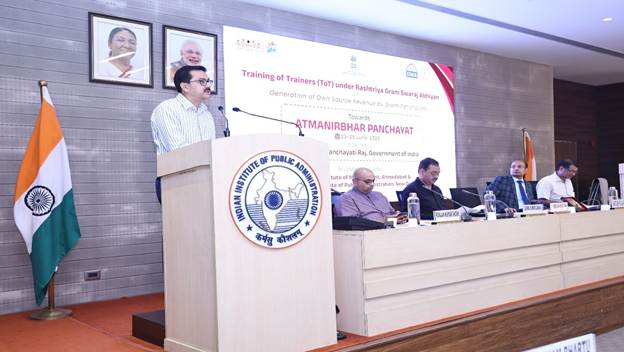Training Push to Boost Panchayat Revenues: MoPR, IIM-A Launch National ToT
Keynote speaker Shri Vivek Bharadwaj, Secretary, MoPR, framed OSR as the litmus test of Panchayat maturity.

- Country:
- India
India’s Gram Panchayats collectively manage nearly a third of all public spending at village level, yet most still rely on state and central transfers. Recognising that sustainable development demands local fiscal muscle, the Ministry of Panchayati Raj (MoPR) has inaugurated a three-day Training of Trainers (ToT) on “Generation of Own Source Revenue (OSR) by Gram Panchayats” at the Indian Institute of Public Administration (IIPA), New Delhi. The course, crafted by IIM Ahmedabad under the flagship Rashtriya Gram Swaraj Abhiyan (RGSA), gathers 65 master trainers drawn from 16 States and UTs.
A Vision of ‘Ātmanirbhar Panchayats’
Keynote speaker Shri Vivek Bharadwaj, Secretary, MoPR, framed OSR as the litmus test of Panchayat maturity. Fiscal autonomy, he argued, “is not merely a bookkeeping exercise; it is a mirror of leadership credibility and community trust.” By urging participants to develop state-specific revenue playbooks, he linked the training directly to the Government’s broader goal of creating Atmanirbhar (self-reliant) Panchayats, capable of funding—and prioritising—their own development projects.
Policy Backdrop and Digital Enablers
Additional Secretary Shri Sushil Kumar Lohani highlighted several parallel reforms:
-
Model OSR Rules: A template statute, distilled from diverse state laws, will soon be circulated for adoption.
-
Digital Tax Collection Portal: A cloud-based platform, customisable by each Panchayat, promises transparent billing, smoother audits, and real-time dashboards.
-
Data-Driven Planning: Upcoming integrations with the Panchayat Enterprise Suite allow revenue data to feed automatically into Gram Panchayat Development Plans (GPDPs).
Inside the Curriculum
IIM-Ahmedabad faculty have built an applied syllabus that blends behavioural economics with public-finance rigour. Nine thematic blocks structure the programme:
-
Foundations and legal bases of OSR (levies, fees, service charges)
-
Strategy design: mapping untapped revenue streams
-
Behavioural nudges for better tax compliance
-
Linking OSR to visible village improvements to build payment culture
-
Innovative financing (PPP models, land-value capture, green bonds)
-
Project financing: aligning revenue forecasts with credit options
-
SWOT analysis to diagnose local barriers and catalysts
-
Revenue forecasting models for five-year GPDP cycles
-
Project-management tools for timely execution and monitoring
Live case studies—from Goa’s beach-tourism cess to Odisha’s community-led water-tax reform and Gujarat’s solar-powered street-lighting fee model—ground theory in practice.
Cascade Model and Timelines
The current cohort will mentor state-level resource pools, who in turn will train district and block officials. A second ToT in July 2025 will cover the remaining States/UTs, after which MoPR expects each state to launch its own OSR drive by the next GPDP cycle (2026-27).
Long-Term Payoff
Strengthening OSR is projected to:
-
Reduce delays linked to grant disbursal and conditionalities
-
Encourage citizen oversight, as residents can see a direct link between local taxes and improved amenities
-
Boost creditworthiness, enabling Panchayats to leverage loans or bonds for larger infrastructure projects
-
Free up state budgets for high-order services while decentralising day-to-day functions
Looking Ahead
The Ministry plans to establish Centres of Excellence on critical revenue themes (property valuation, tourism levies, waste-management user fees) and seed-fund start-ups working on low-cost GIS mapping and e-governance tools. By 2030, MoPR envisions a nationwide network of financially robust Panchayats capable of shouldering a larger share of India’s rural development agenda.










